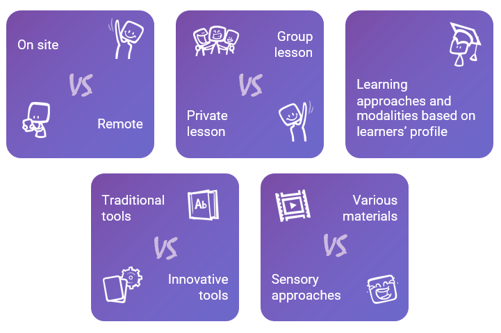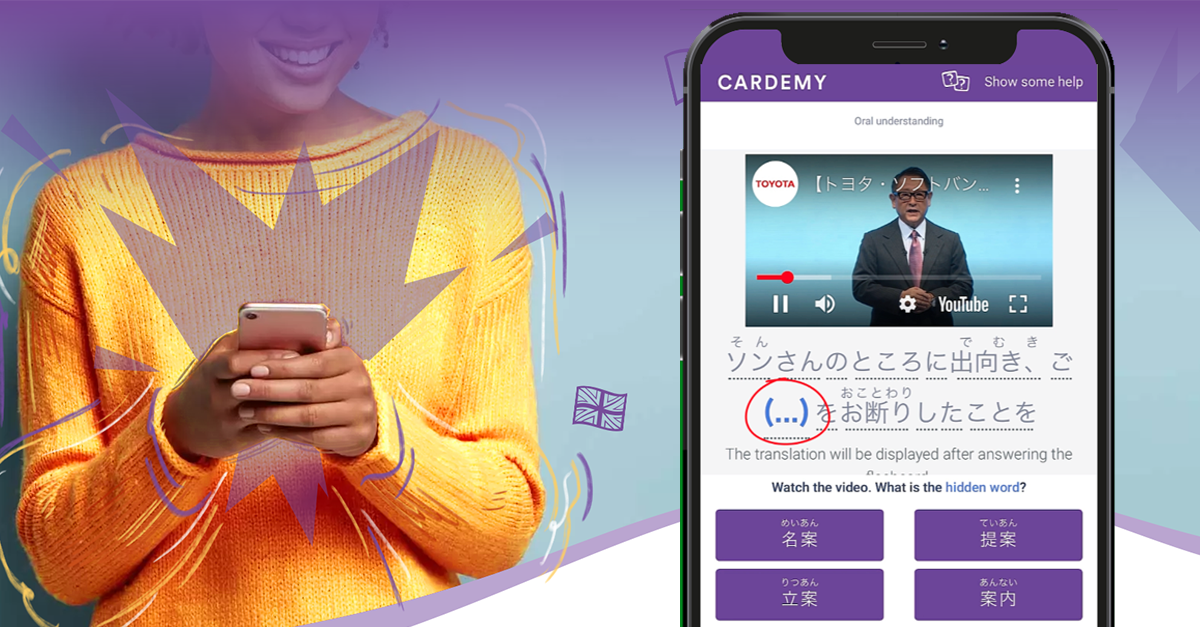Your training courses are a proof: there is not a single course today that is not multimodal. Are you uncertain about how you apply this concept? I'm sure you'll recognise some of the principles below:

In other words, multimodality is the combination of educational situations that consider 3 elements:

As a foreign language teacher, multimodality is essential for working with your learners on all language skills. The modalities, methods and activities proposed to them must meet the identified pedagogical objectives, by promoting the construction of knowledge and its application by all your learners.
I felt this in the many interviews with language teachers I ran: creating a link between all the identified needs is a major challenge for you. Even better, you are passionate about it. You are constantly trying new methods and approaches, new tools... You even turn to neurosciences to understand how the brain works!
By the way, what do the neurosciences tell us about multimodality?
Multimodality promotes memorization
It’s true, you don't need neuroscience to know that the construction of knowledge and its application necessarily involve memorization. But in recent years, numerous studies have been published to demonstrate how the brain works and its ability to memorise information.
If you want to learn a little about the subject, you can listen to this very accessible podcast to understand how the brain learns and how we can promote learning:
https://www.supplychainbrain.com/media/podcasts/1211/play/2841
And read this publication for more theory on memorization:
https://core.ac.uk/download/pdf/9306316.pdf
If you don't have time to investigate the subject, here is a very short summary below.
There are three types of memory (sensory memory, working memory and long-term memory). The brain stores information in the form of stimuli received in the brain in different areas:

Source: https://mantlemarketing.wordpress.com/2014/10/22/the-brain-has-several-ways-of-learning
Many tips and tricks have been found to stimulate the learning-brain and optimise the memorisation process, some of which clearly resonate with the concept of multimodality mentioned in the first part of this article:
- Vary the signals (visual, auditory, tactile, etc.), and therefore the media
- Individualise the training according to the learner's needs
- Repeat information over time and in different formats
- Work on the cognitive aspect of learning by adding meaning to the signals transmitted to them.
Does this sound familiar to you too?
These are the marketing arguments of all the digital tools on the market today!
- "Learn with multimedia",
- "Personalise your course",
- "Combine self-learning with tutored lessons",
- "Stay motivated in the long run"
So that's why you too have tried out many digital tools, or even subscribed to benefit from these magical packages. But you admit that these promises are not always kept, at least if you don't get your hands dirty...
The 4 main marketing arguments of multimodality that represent an additional challenge for language teachers
I have interviewed many foreign language teachers and all of them have told me about their difficulties with digital tools. In fact, every marketing argument mentioned above commits teachers to work harder. Without having more time though! Let me explain.
- 1. "Learn with multimedia"
As you may have noticed, there are two types of tools: those that allow you to access off-the-shelf content, and those that offer you to create your own content. Sometimes it is a mix of both.
Very rarely do the tools that offer off-the-shelf content have exactly the content you and your learners need. Far from being uninteresting though, it is up to you or your learners to decide whether to use this or that content, as a complement to your courses. This is how a silo is created between your courses and activities and those offered by the tool... Thus, the latter ends up being abandoned and only appearing in your school's curriculum as a marketing tool.
To compensate for this lack of coherence, some tools allow you to create your own content, to add images, videos, text files, sometimes quizzes... This is good, but it takes a lot of time (handle the tool, searching for media, creating activities, etc.) in addition to the time you have to spend designing your own actual courses!
- 2. "Personalise your journey"
To date, no tool on the market really meets this need.
However, many are trying. They make "personalised" recommendations of content, according to the level and learning objectives of each learner. Yes, but this off-the-shelf content is pre- designed for individuals with similar needs (for example, Business English for B1 level), and not for EACH individual... This is a far cry from the personalisation expected!
For the learner to really benefit from personalised content, it is still up to you to create activities for your learners, because you, better than anyone, know their needs. However, as for the designers of off-the-shelf content, it is difficult, if not impossible, for you to meet the needs of each individual. Everyone has a different level and different needs. And need I say it again: your time is not expandable...
- 3. "Combine self-directed learning with your lessons"
Here the argument is simple: the learner benefits from independent learning time, and from lessons. The benefits of working on certain language skills independently (e.g., vocabulary development) are indisputable. And, if learners have always taken home assignments even before the digital age, these new tools allow you to simplify the monitoring of their work.
However, digital tools rarely do better than the handouts you gave them the day before, for the same reason as mentioned above (no link between what they learn in class and on the digital tool). Your students will therefore naturally prefer your handout. That's right, that's what they will be assessed on!
You are beginning to understand now, so it is still up to you to work on digitalising your handouts.
- 4. "Stay motivated in the long term"
This last argument is the bête noire of many digital language learning tools. The churn rate is very high. And for good reason, the last three arguments above are hardly respected, and yet are among the first arguments mentioned by learners to maintain their motivation (100+ interviews).
In addition to these arguments, there are those concerning the contextualisation and concretisation of learning, which they consider too weak on digital tools.
I will therefore conclude this section, not without a little cynicism, by urging you to motivate your learners and remind them of the existence of the digital tool to which you or your school has subscribed...
Multimodal tools must be reinvented and aimed at teachers, to promote learning
In the previous section, I focused on the difficulties encountered by teachers when dealing with digital tools. But let me reassure you: not all is gloomy, on the contrary! Teachers and schools continue to subscribe to digital language learning tools, and this market is constantly growing.
In recent years, new technologies and innovations have enabled all players to improve and to respond better and better to the needs mentioned above: to make up for the lack of time of teachers on the one hand, and to satisfy the needs of personalisation and reinforcement of learners' knowledge on the other.
But to achieve the marketing objectives mentioned above, which are somewhat of a grail for effective memorization, it is necessary to think differently in the years to come...
What if, instead of offering libraries of pre-designed content for individuals with similar needs, the tools offered content that corresponded exactly to the lesson that just took place?
What if the content met the identified pedagogical objectives, while adapting perfectly to the needs of each learner, according to their profile?
What if the teacher only had to guide the tool, without spending time creating activities or searching for content?
These are the challenges we are trying to meet by developing our own tool, Cardemy Fluent with the help of many volunteer teachers.
The idea behind this project is to put the teacher back at the centre of learning. The teacher focuses on the pedagogy of his or her teaching while allowing the students to make the link with the activities in autonomy. The tool allows the teacher to simply direct the learning offered to his or her learners according to the needs of the training programme, while freeing him or her from the creation of digital teaching activities and the search for content for them. He no longer has to prioritize between the time he can devote to the preparation of his courses or to the reinforcement of his learners' knowledge; he can propose an extremely rich multimodal environment to his learners, without any additional effort.
At Cardemy, we are convinced that in order to allow for an optimal multimodality and to meet all the objectives of multimodality, the tools must nowadays reverse the current paradigm and not only aim at learning, but also at teaching.



Leave Comment